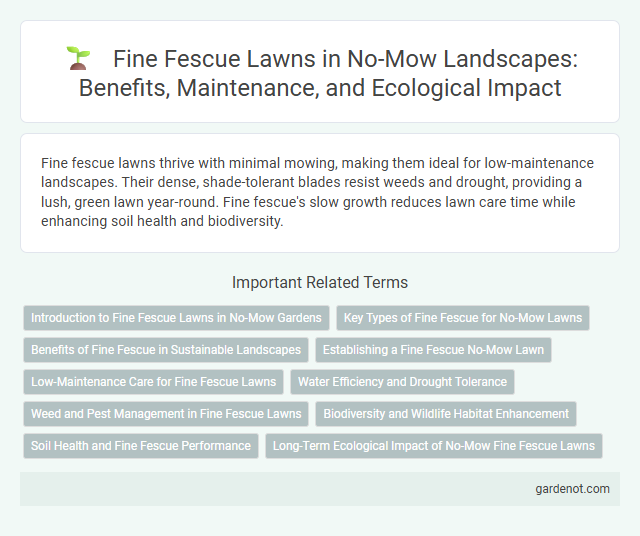Fine fescue lawns thrive with minimal mowing, making them ideal for low-maintenance landscapes. Their dense, shade-tolerant blades resist weeds and drought, providing a lush, green lawn year-round. Fine fescue's slow growth reduces lawn care time while enhancing soil health and biodiversity.
Introduction to Fine Fescue Lawns in No-Mow Gardens
Fine fescue lawns thrive in no-mow gardens due to their low growth rate and minimal maintenance requirements. This grass variety tolerates shade and poor soil conditions, making it ideal for sustainable, eco-friendly landscapes. Fine fescue also conserves water and reduces the need for fertilizers, supporting environmentally conscious lawn care.
Key Types of Fine Fescue for No-Mow Lawns
Fine fescue varieties ideal for no-mow lawns include Creeping Red Fescue, Chewings Fescue, Hard Fescue, and Sheep Fescue, each offering unique drought tolerance and shade adaptability. Creeping Red Fescue excels in shaded areas with its rhizomatous growth, while Hard Fescue thrives in low-maintenance, low-nutrient soils. Selecting the appropriate fine fescue type enhances lawn sustainability by reducing mowing frequency and maintenance requirements.
Benefits of Fine Fescue in Sustainable Landscapes
Fine fescue lawns excel in sustainable landscapes due to their low water requirements and natural resistance to pests and diseases, reducing the need for chemical inputs. Their deep root system enhances soil health and promotes carbon sequestration, contributing to environmental resilience. Fine fescues also tolerate shade and poor soil conditions, making them ideal for diverse urban and suburban settings focused on ecological sustainability.
Establishing a Fine Fescue No-Mow Lawn
Establishing a fine fescue no-mow lawn requires selecting shade-tolerant fescue varieties such as hard, chewings, or sheep fescue, which thrive in low-maintenance environments. Prepare the soil by aerating and ensuring well-drained conditions, then sow seeds at a rate of 4 to 6 pounds per 1,000 square feet for optimal coverage. Maintain the lawn by watering deeply but infrequently, promoting deep root growth and minimizing the need for mowing throughout the growing season.
Low-Maintenance Care for Fine Fescue Lawns
Fine fescue lawns excel in low-maintenance care due to their drought tolerance and minimal fertilization needs, making them ideal for sustainable landscaping. These grasses require less frequent mowing, typically every three to four weeks during peak growth, reducing labor and equipment costs. Their ability to thrive in shady conditions and poor soils further lowers maintenance demands compared to traditional turfgrass species.
Water Efficiency and Drought Tolerance
Fine fescue lawns excel in water efficiency by requiring significantly less irrigation compared to traditional turf grasses, making them ideal for drought-prone areas. Their deep root system enhances drought tolerance, allowing them to survive extended dry periods without browning. This resilience reduces water consumption, promoting sustainable lawn care and lowering utility costs.
Weed and Pest Management in Fine Fescue Lawns
Fine fescue lawns naturally resist many common weeds and pests due to their dense growth and shade tolerance, reducing the need for chemical treatments. Effective weed management involves maintaining proper mowing height and overseeding thin areas to prevent weed establishment. Integrated pest management practices, including regular monitoring and encouraging beneficial insects, help keep pests like billbugs and armyworms under control without harming the lawn ecosystem.
Biodiversity and Wildlife Habitat Enhancement
Fine fescue lawns significantly enhance biodiversity by providing a dense, drought-tolerant groundcover that supports pollinators such as bees and butterflies. This grass species creates a favorable habitat for beneficial insects and small wildlife, promoting ecological balance in urban and suburban areas. Low maintenance needs reduce chemical inputs, further benefiting soil health and local ecosystems.
Soil Health and Fine Fescue Performance
Fine fescue lawns enhance soil health by promoting microbial diversity and improving soil structure through their dense root systems. This species thrives in low-fertility soils with minimal maintenance, maintaining strong performance in shaded and drought-prone areas. Fine fescue's adaptability reduces the need for frequent mowing and chemical inputs, supporting sustainable lawn care practices.
Long-Term Ecological Impact of No-Mow Fine Fescue Lawns
No-mow fine fescue lawns significantly enhance biodiversity by providing a stable habitat for pollinators and soil microbes, leading to healthier ecosystems over time. These lawns improve soil health through deep root systems that increase carbon sequestration and reduce erosion. The reduced need for mowing and chemical inputs lowers greenhouse gas emissions and minimizes water usage, promoting sustainable landscape management.
Fine fescue lawn Infographic

 gardenot.com
gardenot.com